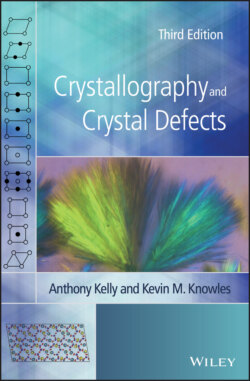Читать книгу Crystallography and Crystal Defects - Anthony Kelly - Страница 51
2.18 Magnetic Groups
ОглавлениеThese point groups and space groups are an extension of the 10 two‐dimensional and 32 three‐dimensional point groups and the 17 two‐dimensional space groups and 230 three‐dimensional space groups. They recognize the effect of an antisymmetry operation on these groups.
Antisymmetry defined by Alan Mackay is ‘the correspondence of faces, points or other crystallographic objects having some property denoted by a positive sign to other faces, points or objects symmetrically related in position, but having the same property denoted with the opposite sign’ [24].
An example of an antisymmetry operation is magnetic spin, so that each atom site can have one of two possible values: spin ‘up’ or spin ‘down’ when the magnetic moments are not randomly arranged, but are instead aligned. A further example is where one atom is coloured one colour, say black, and the other identical atom symmetrically related in position is coloured a different colour, say white.
These groups are known by a variety of names:
magnetic groups,
antisymmetry groups,
Shubnikov groups (after Aleksei Vasilevich Shubnikov, 1887–1970),
Heesch groups (after Heinrich Heesch, 1906–1995, who introduced the concept of antisymmetry in his 1930 paper [25]),
dichromatic groups,
black‐and‐white groups.
Groups where equal and opposite black and white objects are exactly superposed are termed grey groups.
The principle behind the extension of the ‘conventional’ point groups and space groups can be illustrated in two dimensions by considering the five two‐dimensional Bravais lattices (Figure 1.14). If these five two‐dimensional lattices are centred by (lattice) points of a different colour, the number of permissible Bravais lattices increases from 5 to 10, as shown below in Figure 2.26 [24].
Figure 2.26 The 10 black‐and‐white plane lattices: (a) parallelogram (oblique), (b) rectangular, (c) square, (d) equiangular (hexagonal) (after [24])
Here, the five ‘conventional’ two‐dimensional Bravais lattices consistent with translational symmetry have lattice points shown as circles. The five new Bravais lattices which arise from the centring are shown as lattices with the same numbers of circles and dots per unit cell.
In two dimensions there are in total 46 black‐and‐white point groups, to which can be added 17 ‘ordinary’ plane groups and 17 grey groups, giving 80 plane groups in total. In three dimensions there are 1651 Shubnikov space groups: 230 ‘ordinary’ space groups, 230 grey groups, 674 groups where antisymmetry alone generates further groups and 517 where antitranslations and antisymmetry generate further groups [26].
An example of a material where these considerations are relevant is MnO below its Curie temperature of 120 °C. Above 120 °C MnO has the NaCl crystal structure (Section 3.5.1, Figure 3.16). As is shown in Figure 2.27, the effect of antisymmetry, in this case antiferromagnetic coupling, has the effect of doubling the actual magnetic unit cell relative to the chemical unit cell [27].
Figure 2.27 The effect of antiferromagnetic coupling on the size of the unit cell in MnO. In alternate {111} planes, shown as dotted lines, Mn atoms are either spin ‘up’ or spin ‘down’. As a result, the magnetic unit cell has a cell size twice that of the chemical unit cell. For ease of representation, only Mn atoms are shown in this diagram
An extended introduction to magnetic groups is given in chapter 3.6 of [3]. A complete discussion and descriptions of the magnetic groups is given in the recent book by Litvin [28]. The book by Shubnikov and Kopstik has, in addition, a discussion of coloured symmetry groups – groups relating objects of more than two colours, together with a full set of references to prior work in this area [26].
